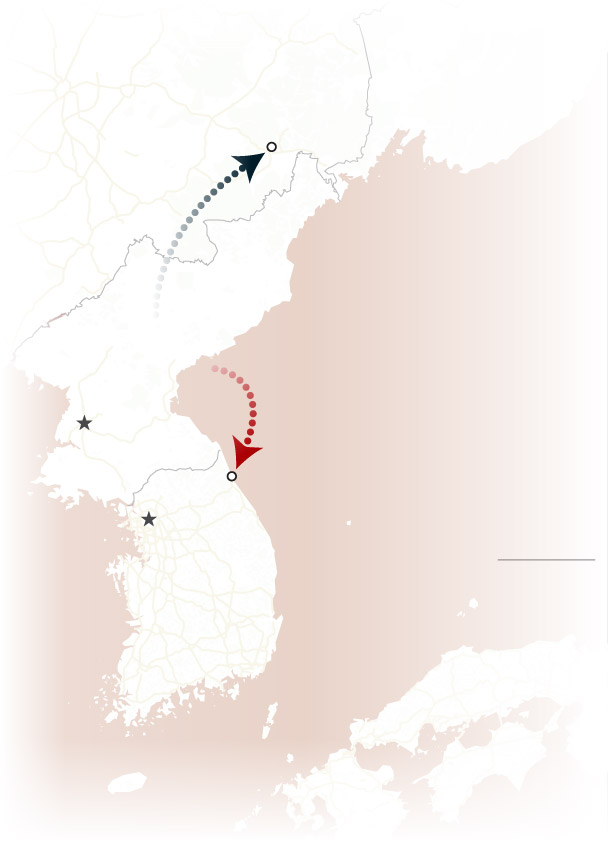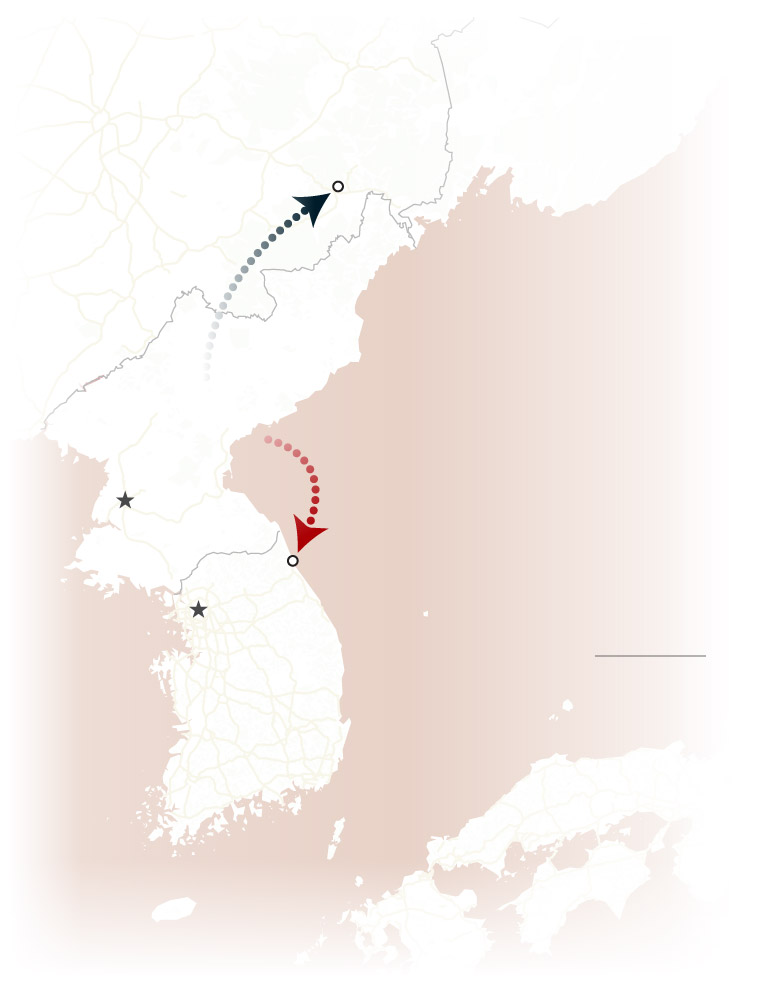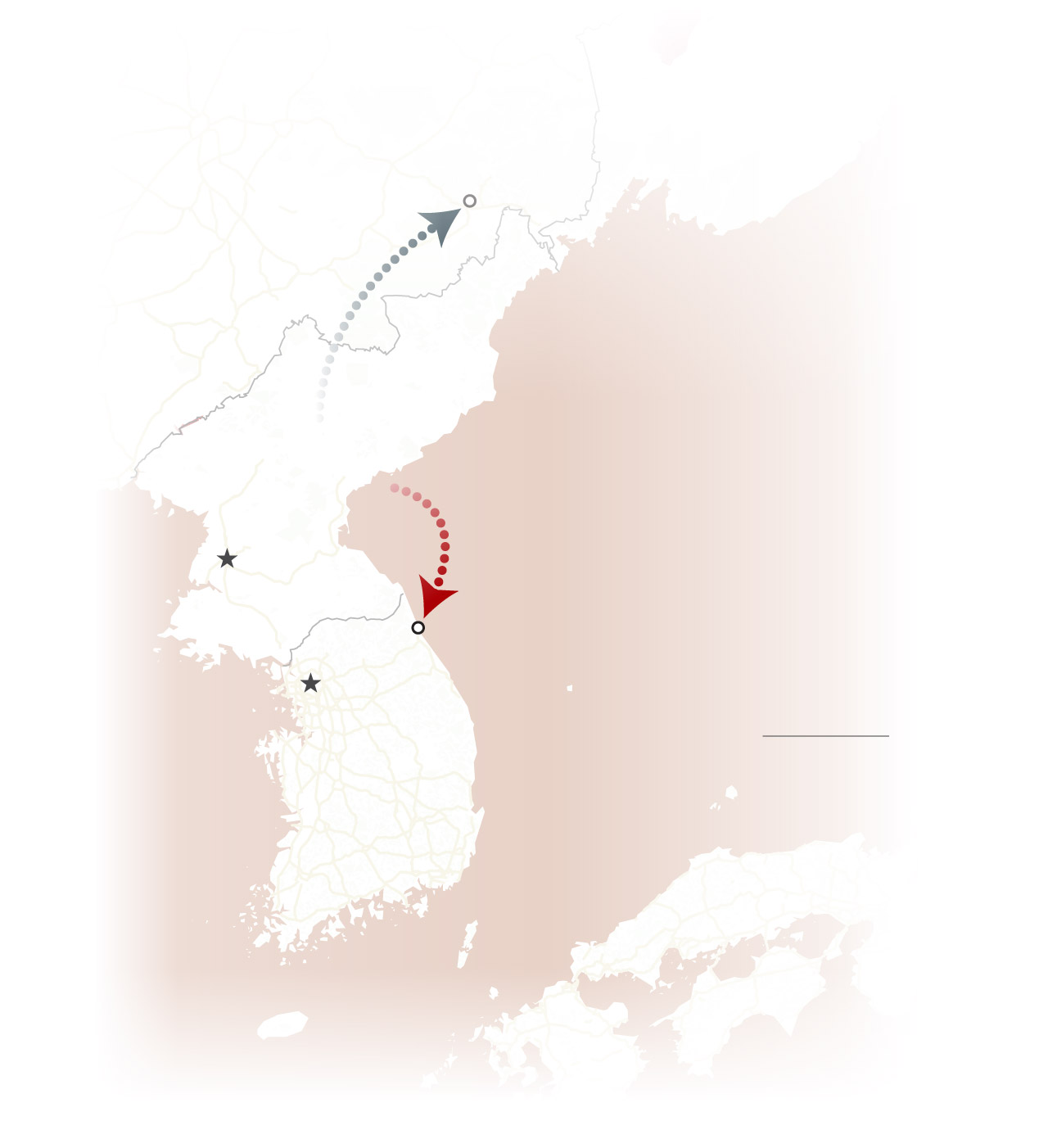SEOUL — Hardly anyone has escaped from North Korea these past four years, since leader Kim Jong Un shuttered his country’s border with China in the earliest days of the pandemic.
But Kang Gyu-rin and her mother, aunt and a family friend are among the few. To do so, they used a perilous route that has become almost the only option for escape: by sea.
One night last October, the four boarded Kang’s rickety wooden boat — with a rudimentary pumping system for bailing out the water — and set out for South Korea. Or death.
“I was ready to die, so I wasn’t afraid,” said Kang, now 23. “We had to give it our best shot.”
Kang and her mother, Kim Myung-sook, told The Washington Post about their life during the covid era and their decision to flee by sea, offering rare insight into how North Korea has changed in the past four years. The women changed their names after arriving in the South because they are escapees and wanted to protect family members back home. They spoke to The Post on the condition that their new names be used.
North Korea, run by the totalitarian Kim regime for almost eight decades, has long been one of the world’s most reclusive and repressive countries, a dire place in which to live but an extremely difficult place from which to escape.
It was in the late 1990s, at the height of a devastating famine in the North, that waves of escapees started arriving in the South, almost all of them taking an overland route across the relatively porous border into China, then to Mongolia or down through Southeast Asia, where they could fly to South Korea.
Some 33,000 North Koreans had arrived in the South that way. But that stopped in January 2020, when Kim Jong Un slammed shut the borders and then erected new barbed-wire fencing and watchtowers — making it impossible for anyone to cross into China without permission.
Kim has now essentially ushered in a “zero escapees era,” human rights advocates say.
How we reported this story
While some North Koreans who were already outside the country when the pandemic struck, such as laborers sent to Russia, have arrived in South Korea since 2021, only 15 or so people have been able to flee North Korea and make it south, according to estimates from defector-support organizations. That number includes Kang and her family.
That makes their account extremely valuable. Yet North Korean escapees’ stories are notoriously difficult to corroborate because journalists can’t reach residents or officials who can confirm their accounts. Kang’s aunt and the male family friend who steered their boat declined to be interviewed.
The Post cross-checked Kang’s account with two advocacy organizations in Seoul that have interviewed her — the Database Center for North Korean Human Rights and Liberty in North Korea — and confirmed that key details were relayed consistently. The Post met Kang and her mother independently of the advocacy groups.
Julie Turner, U.S. special envoy for North Korean human rights issues, has also met with Kang and was struck by the lengths to which she went to escape.
“The desperation piece has stuck with me,” Turner said, noting that North Koreans are having to resort to boats. “People are still so hungry for opportunities that they’re looking at these much more treacherous routes.”
Map of main routes for those fleeing North Korea
The land route through China carried immense risks, including repatriation to North Korea — and extreme punishment — if caught. But in China, a network of brokers and activists helped North Koreans to safety. It was expensive and dangerous, but it was possible.
Escaping by sea is even riskier: Those fleeing must contend with border patrols on the coast and at sea, as well as woefully inadequate boats and unpredictable weather. Even seasoned North Koreans struggle to fish given the challenging conditions: Battered wooden “ghost ships” regularly wash up on Japan’s western shores, carrying the corpses of fishermen who have starved at sea.
Kang and her mother had heard of other families who fled on boats. It wasn’t until they arrived in South Korea that they realized none of those families made it alive.
If escapees make it to the South’s waters, they risk South Korean patrols mistaking them as hostile intruders — and potentially firing upon them.
The water route may not even last much longer, with North Korea erecting new fencing around its coastlines to try to stop people from accessing the sea.
But for Kang and her family, the sea was the only way out. And they were only able to make the journey because they lived near the coast and Kang had a boat because she worked in the fishing industry.
This is just one family’s story, but it is one that reflects just how difficult it has become for ordinary people to live in North Korea — and to escape it.
New, ‘suffocating’ pressures
(Mikyung Lee/The Washington Post)
Kang and Kim lived a middle-class life in South Hamgyong province on the east coast, although they were far from the border with China, where almost all trade happened. That didn’t matter much before the pandemic because the market economy had well and truly taken hold across North Korea.
But then came the border closures. Then crackdowns on food vendors and the markets that sustain the North Korean economy, they said. Their quality of life deteriorated sharply.
“We talk about how life felt hard in 2019 [before the pandemic], but now that we look back, those were the good years. It will be difficult to return to the way we lived then,” Kang said.
Items that used to trickle into the country from China became exponentially more expensive or disappeared, they said. The shortage of inventory showed Kang just how much her country depended on its northern neighbor, she said.
“Even sewing needles became 10 times more expensive. I wondered why, and of course, they turned out to be a Chinese product. I realized how little my country actually produces,” Kang said.
The Post cannot independently verify her claims, but South Korean officials and reporting from North Korea-monitoring websites have similarly reported on price hikes and cash shortages created by crackdowns.
“There needs to be a flow of products into the markets, either through production from North Korean companies or via China, but neither of those things were happening,” said Lee Sang-yong, director of research and analysis at Daily NK, a media outlet with informants in the North, including in Kang’s home province.
These pressures are “suffocating” residents who can no longer navigate the markets like they used to, said Kim, who is 54. She recalled the famine of the 1990s and the capitalist smarts it took for people to survive it — making, selling or buying items they could trade for food.
“Now, it feels unsustainable even for the savviest,” Kim said. “The government is taking over [the markets], but they’re not giving us anything else in return.”
Kang recalled the summer of 2022, when the North Korean regime first publicly admitted to a coronavirus outbreak. North Korea then claimed it eradicated the “fever” virus in just three months, and that just 74 “fever” patients — about 0.0003 percent of its population — died, which would make North Korea’s covid fatality rate the lowest in the world.
Experts believe it is an undercount of the true toll of the spread of the virus, especially given North Korea’s lack of coronavirus testing kits and vaccines. Kang believes she and nearly everyone she knew caught the virus then. The mismatch between the regime’s version of events and the reality on the ground sowed another seed of distrust.
Kang’s recollections, together with accounts from some other recent escapees, are early indicators of potentially profound shifts that took place inside North Korea during the pandemic, said Sokeel Park of Liberty in North Korea.
The extreme restrictions on movement, coupled with acute food shortages, have torn up the implicit social contract that enabled people to fend for themselves if the government can’t provide, Park said. This raises bigger questions about how North Korean people view their government, he said.
“Different escapees are telling us independently that North Korean people’s sentiment and mentality evolved significantly during the pandemic in a more disaffected and skeptical direction,” Park said.
A chase, then a welcome
After Kang dropped out of college during the pandemic to make money, she bought the boat with her mom’s help — her mother had $4,000 in savings, a fortune in North Korea — to start a small fishing operation.
Business was brutal, she said. Diesel was expensive, the boat kept needing repairs, she had to pay workers even when there was no seafood to catch.
She kept track of inventory and revenue in bookkeeping notebooks, which she brought south and showed a Post reporter. They confronted her with a grim reality: The business was not sustainable.
She’d always known the boat could help her escape one day. But she started seriously planning her escape last spring, mapping out her steps and routes, and put her plan into motion the evening of Oct. 22, 2023.
Preparing for their journey, they packed water, dried noodles, bread, rice and sleeping pills — which they agreed to take if it became clear they would be caught by the North Korean coast guard. They preferred a peaceful death to execution or prison camps.
The waves that night were unexpectedly high, lifting their boat off the water at each crest and crashing it down at each trough, Kang and Kim said.
Still, they were making progress. They were about two hours from crossing the maritime border. Then they spotted a North Korean patrol ship heading toward them.
“They just kept flashing, flashing, flashing their lights. They wouldn’t let up,” Kang said. “I wondered, is it time for the pills? My heart was beating so much.”
Kim, who was comforting her seasick sister, said all she could do was pump out water and pray for survival: “I hoped that the heavens did not send us on this journey just to die.”
It’s unclear why the patrol vessel did not intercept them. The moment they reached the maritime border, the lights disappeared, the patrol boat heading back north, they said.
It was about 7 a.m. on Oct. 24 when blowfish catcher Lim Jae-gil spotted Kang’s boat. He had heard warnings on the radio transmitter that North Korean law enforcement vessels were heading south, and immediately knew this was the boat they had been chasing.
He had never seen anything like Kang’s boat in more than a decade of fishing off South Korea’s east coast, about 35 miles away from the border. It looked like it should have been sent to the scrapyard long ago, Lim, 62, said in an interview.
Lim called the authorities while he steered toward it. When he got close, one of the North Koreans asked: “Where are we?”
“Sokcho, in Gangwon province,” Lim replied. “Are you from North Korea?”
The North Koreans nodded. “Well done,” Lim said.
The four boarded Lim’s boat and waited for the South Korean coast guard. Lim offered the arrivals cigarettes and water. The North Koreans had packed plenty of both, but Kang said they accepted because they wanted to experience the taste of South Korean cigarettes and water.
The man took one puff of the cigarette and flicked it into the sea. “It was so much weaker than the cigarettes we were used to,” Kang recalled.
As for the water: “It was the same. It’s water,” she said, laughing. “But everything felt so interesting at the time.”
A new life in the South
(Mikyung Lee)
Like many North Koreans, Kang learned about life in the South through its television programs, which she started watching as a teen. It was illegal, but everyone did it.
Kang is among the cohort of North Koreans who grew up after the famine, learning to navigate capitalism and access products from China and South Korea — including TV shows and movies that opened their eyes to life in a rich and free society. They have become more exposed to the outside world and disillusioned with their own government, experts say.
“We don’t believe [the propaganda],” Kang said. “Maybe our parents did way back when but I don’t know any of that myself. … I’ve seen lots of dramas, and I knew life in North Korea was really awful.”
It’s because of this generation’s awareness of life outside North Korea — and the threat this knowledge poses to the long-term survival of the regime — that Kim Jong Un has cracked down on foreign influence, from fashion to slang. In December 2020, North Korea adopted a law “rejecting reactionary ideology and culture,” according to state media.
Tightening controls, down to her earring choices, made Kang feel like a “kindergartner,” she said.
Kang no longer has to worry about such demands. She wears gold-colored jewelry and colored contact lenses, and has dyed her hair reddish-brown. Her smartphone is constantly buzzing, and her drink of choice — like most every other South Korean Gen Zer — is iced coffee.
Now, Kang is preparing for college and hopes to one day study abroad. Her mother, who is looking for a job, worries about the long hours her daughter spends studying.
They brought almost nothing with them from North Korea. But Kang has her bookkeeping notebooks, their pages damaged from the waves, and looks at them to motivate herself through hardships. She also has a photo she took at a studio in the North. Its caption reads: “To a life that is always filled with exciting and happy times.”
About this story
Story by Michelle Ye Hee Lee. Illustrations by Mikyung Lee. Story editing by Anna Fifield. Design by Andrew Braford. Design editing by Joe Moore. Map by Samuel Granados. Copy editing by Kim Chapman.










